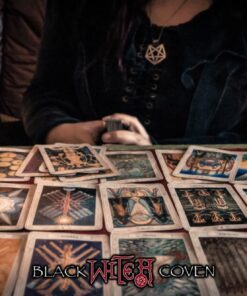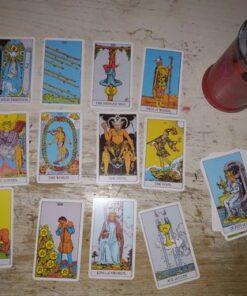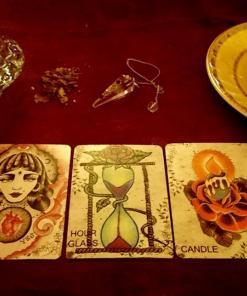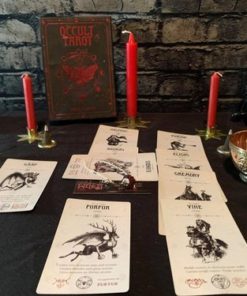Below is a detailed discussion of Aim (also spelled Aym, Haborym, or Aini), the 23rd demon listed in the Ars Goetia of the Lesser Key of Solomon.
I’ll explore his origins, appearance, powers, personality, summoning considerations, and cultural significance, drawing from primary sources like the Ars Goetia, Johann Weyer’s Pseudomonarchia Daemonum, and Collin de Plancy’s Dictionnaire Infernal, as well as modern interpretations up to April 2025. This aligns with the depth of prior demon analyses (e.g., Asmodeus) and avoids speculative leaps beyond established lore.
Origins and Historical Context
Aim, ranked as a Great Duke of Hell commanding 26 legions of demons, emerges from the rich tapestry of 17th-century European demonology, codified in the Ars Goetia. His name likely derives from linguistic distortions of Hebrew or Aramaic roots—possibly linked to Ayom (terrible) or Ain (eye, insight)—though no definitive etymology exists. He’s absent from earlier Jewish texts like the Book of Tobit (unlike Asmodeus), suggesting a later Christian invention or adaptation from obscure sources.
In Weyer’s Pseudomonarchia Daemonum (1577), Aim appears as “Aym or Haborim,” a precursor to the Ars Goetia’s listing, itself compiled around 1641 from Weyer’s work and other medieval grimoires (e.g., Livre des Esperitz). His depiction as a fallen angel aligns with the Goetic narrative—once a Cherub or similar rank, he rebelled with Lucifer, crashing into Hell to assume his infernal dukedom. The Dictionnaire Infernal (1863) by Collin de Plancy reinforces this, though it debates his identity, with some conflating him with Raum (the 40th Goetic spirit), a connection de Plancy dismisses due to distinct traits.
Aim’s fiery, destructive bent hints at Zoroastrian influences (e.g., Aeshma, demon of wrath), filtered through Christian demonology’s lens, where fallen angels become tools for human ambition—arson and wit, in his case. His 26 legions, fewer than Asmodeus’s 72 or Paimon’s 200, mark him as mid-tier yet formidable among Hell’s nobility.
Appearance
The Ars Goetia describes Aim vividly: “He appeareth in the form of a very handsome man in body, but with three heads; the first, like a serpent, the second like a man having two stars on his forehead, the third like a calf. He rideth on a viper, carrying a firebrand in his Hand, wherewith he setteth cities, castles, and great Places, on fire.” Weyer aligns closely, swapping the calf for a cat, while de Plancy notes both variants.
- Three Heads:
- Serpent: Symbolizes cunning, venom, and primal chaos—perhaps a nod to Eden’s tempter or Hell’s serpentine roots.
- Man with Two Stars: Insight and duality—stars suggest celestial origins or piercing intellect, marking him as a seer among demons.
- Calf (or Cat): The calf evokes innocence corrupted (e.g., the Golden Calf), or sacrifice; the cat variant (Weyer) implies stealth and predation. The discrepancy reflects translation flux—calf (vitulus) and cat (felis) diverging in grimoires.
- Viper Mount: Reinforces his serpentine theme—agility, danger, a living weapon.
- Firebrand: His torch, blazing and chaotic, ties him to destruction—an arsonist’s tool, not a scholar’s quill, despite his wit.
This chimeric form—handsome yet grotesque—distinguishes him from Asmodeus’s regal dragon-rider or Sitri’s sleek leopard-man. Aim’s beauty lures, his heads warn, and his fire consumes—a triple threat incarnate.
Powers and Abilities
Aim’s powers, per the Ars Goetia, are concise yet potent:
- Arson: “Setteth cities, castles, and great places on fire”—a literal or symbolic power to raze obstacles, physical or metaphysical. Weyer adds he “fires castles and cities,” emphasizing scale.
- Wit: “Maketh thee witty in all manner of ways”—grants cleverness, adaptability, or rhetorical skill, a mental edge over foes.
- Truth in Private Matters: “Giveth true answers unto private matters”—reveals secrets, hidden truths, or personal insights, less cosmic than Paimon’s scope but piercingly specific.
- 26 Legions: Commands a modest but loyal force—enough to execute his will without rivaling kings like Asmodeus.
In Pseudomonarchia Daemonum, Weyer mirrors this: wit, truth, and fire, suggesting consistency across texts. The Dictionnaire Infernal implies he’s an arsonist by trade, summoned historically to destroy enemy strongholds—perhaps by medieval conjurers targeting rival lords. His wit and truth tie to his human head’s stars—celestial remnants turned infernal tools—while his firebrand channels his fallen Cherubic might into chaos.
Compared to peers:
- Vs. Asmodeus: Aim’s lust-free focus and smaller legion contrast with Asmodeus’s seductive sprawl.
- Vs. Zepar: Zepar binds love; Aim burns barriers—complementary, not overlapping.
- Vs. Raum: Both destroy, but Raum steals while Aim ignites—distinct motives.
Personality and Nature
Aim’s traits emerge from his powers and form:
- Destructive: His firebrand marks him as a bringer of ruin—less subtle than Paimon’s teachings or Bune’s riches. He revels in chaos, a trait tied to his Cherubic fall—once a light-bearer, now a flame-thrower.
- Cunning: His wit suggests a sharp mind—perhaps sarcastic or playful, twisting words to enlighten or deceive. The Ars Goetia’s “all manner of ways” implies versatility—debate, strategy, or dark humor.
- Perceptive: His truth-telling hints at a piercing gaze—those forehead stars aren’t decorative. He sees through facades, a trait suiting private confessions over grand prophecies.
- Proud: As a Great Duke, he carries noble arrogance—less commanding than a king (Asmodeus) but haughty among dukes. His handsome form suggests vanity, tempered by his monstrous heads.
Unlike Sitri’s overt seduction or Gremory’s gentle persuasion, Aim’s allure is intellectual and destructive—a tempter who offers power through ruin and insight. He’s a Day Demon (per Goetic tradition), strongest at noon—solar fire aligning with his torch.
Summoning Considerations
Summoning Aim requires precision, given his fiery volatility and mid-tier rank. Here’s a practical guide based on Ars Goetia and modern practice:
- Timing: Day Demon—peak power at noon, under sunlight’s glare. Avoid night, when his fire dims.
- Materials:
- Red candle (fire, passion), myrrh incense (dukedom’s bitterness), his sigil (a jagged, flame-like seal), iron (strength), offering (charred wood or sulfur—arson’s scent).
- Circle (salt and ash) and triangle (chalk)—essential to contain his blaze.
- Steps:
- Face south (fire’s domain), light the candle and incense, trace his sigil with iron.
- Chant his enn (modern demonolatry): “Harab serapel Aim ayer.” Then: “Aim, Great Duke of Hell, three-headed torchbearer, I summon thee by thy seal and name.”
- Visualize him—serpent hissing, man staring, calf lowing, viper slithering, firebrand aloft. Command: “Take form I can bear, enter this triangle.”
- State intent—e.g., “Burn my rival’s defenses,” or “Grant me wit to outsmart my foe.”
- Close: “Aim, I honor thy flame. Depart in peace.” Bury the offering in ash.
- Risks: His firebrand could spark literal or metaphorical havoc—anger flaring, plans combusting. The Ars Goetia warns of deceit if unbound; keep him leashed.
Cultural Significance
Aim’s footprint spans occultism and beyond:
- Grimoires: In Pseudomonarchia and Ars Goetia, he’s a mid-tier destroyer—less famed than Asmodeus but practical for conjurers needing ruin or revelation. De Plancy’s Dictionnaire cements his arsonist repute, hinting at historical summons against fortifications.
- Occultism: Modern practitioners (e.g., Black Witch Coven) cast him as a knowledge-bringer and chaos agent—less romantic than Zepar, more volatile than Bune. His wit aids spellcraft or debate.
- Pop Culture: Rare in mainstream media—unlike Paimon (Hereditary) or Asmodeus (Supernatural)—but appears in niche works like Megami Tensei games as a multi-headed demon, emphasizing his oddity.
- Symbolism: Represents intellect turned destructive—Cherubic light warped into infernal flame, a cautionary tale of rebellion’s cost.
Incantation to Summon Aim
Preparation:
Perform this at noon under a blazing sun (Aim is a Day Demon), when his fiery power peaks. Set up an altar facing south (direction of fire and dominion), with his sigil drawn in red ink or charcoal on parchment, a red candle lit (symbolizing his firebrand), myrrh incense burning (for his ducal authority), and offerings such as sulfur powder (arson’s essence) or a charred twig (his destructive touch). Draw a protective circle with salt mixed with ash and a triangle in chalk to constrain his flames. Stand with clear intent—e.g., seeking wit, burning obstacles, or uncovering secrets—and hold an iron object (e.g., a nail) to anchor his strength.
Incantation:
“Aim, Great Duke of Hell’s blazing host,
Triple-crowned lord of serpent’s hiss, man’s starry gaze, and calf’s low cry,
I call thee forth from the smoldering depths!
By thy name, Aim, and the sigil that binds thee,
By the firebrand thou wieldest to raze the proud,
By the wit thou bestowest in cunning streams,
By the truths thou unveilest from shadowed hearts,
I summon thee now into this scorched circle.
Harab serapel Aim ayer—
Thy enn ignites, thy flames arise!
Thou who ridest the viper’s writhing coil,
Thou who brandishest torches to sear the earth,
Three-headed duke, bearer of ruin and light,
Appear before me, fierce and radiant,
In form I may behold, in voice I may hear.
Aim, Sovereign of wit and inferno’s breath,
Step forth from the ashes, honor my call,
And lend thy blazing might to my will!”
Breakdown of the Incantation
- Opening Address:
- “Great Duke of Hell’s blazing host” acknowledges his rank and fiery dominion, grounding the summons in his Goetic status.
- “Triple-crowned lord of serpent’s hiss, man’s starry gaze, and calf’s low cry” invokes his Ars Goetia appearance, visualizing his three heads—serpent for cunning, man with stars for insight, calf for grounded force—to draw him near.
- Invocation by Name and Powers:
- “By thy name, Aim, and the sigil that binds thee” uses his name and sigil as traditional anchors, compelling his presence per Solomonic practice.
- Listing his powers—“firebrand to raze,” “wit in cunning streams,” “truths from shadowed hearts”—highlights his domains, signaling the summoner’s intent (e.g., burning a rival’s defenses, gaining cleverness).
- Enn Integration:
- “Harab serapel Aim ayer” is Aim’s enn, a modern demonolatry chant (attributed to practitioners like S. Connolly). It’s a vibrational key, enhancing the incantation’s pull—his fiery essence resonating through the words.
- Command to Appear:
- “Appear before me, fierce and radiant” balances authority with reverence, requesting a form the summoner can withstand (his firebrand and viper might overwhelm).
- “In form I may behold, in voice I may hear” ensures clear interaction, vital for his wit and truth-sharing.
- Closing Call:
- “Sovereign of wit and inferno’s breath” honors his dual role as a destroyer and enlightener, reinforcing the purpose—power through flame and intellect.
- “Lend thy blazing might to my will” invites his aid, setting up a specific request post-summoning (e.g., “Burn my enemy’s plans”).
How to Use
- Recite Aloud: Speak with sharp conviction, repeating the enn three times if needed to stoke the energy. Visualize Aim—serpent head hissing, starry-eyed man smirking, calf head lowing, viper slithering beneath, firebrand spitting sparks—as you chant.
- State Intent: Pause, then declare your demand: e.g., “Aim, set my rival’s fortunes ablaze,” or “Grant me wit to unravel their lies.”
- Close Respectfully: End with, “Aim, I honor thy torch. Depart in peace with my thanks.” Extinguish the candle, scatter the sulfur or bury the twig in a dry, barren spot—his domain.
Conclusion
Aim, Great Duke of Hell, is a paradox—handsome yet monstrous, witty yet ruinous. His three heads weave cunning, insight, and chaos; his firebrand burns away obstacles, literal or not. Less a lover (Zepar) or king (Asmodeus), he’s a tactician of destruction—perfect for clients like Isabella seeking to raze rival temptations or Kajul craving mental sharpness under stress. His 26 legions and fiery pride make him formidable, but his mid-tier rank keeps him approachable—summonable with care, not dread. He’s no headliner among the 72, but his niche—wit and flame—carves a unique infernal mark.
Classic References
“Amy – One of the 72 spirits of Solomon. Said to be supreme president of hell. He will trade knowledge for the human soul.” – Source: The Complete Book of Demonolatry S. Connolly – http://amzn.to/2dVM1qQ
“Amy – A Great President of Hell, who has thirty-six legions of demons under his command. He teaches Astrology and all Liberal Sciences, gives good familiars, and can find treasures that are kept by spirits. According to Pseudomonarchia Daemonum he hopes to be an angel again after one thousand and two hundred years. He is depicted as a flaming fire, but after a while changing shape into a man. Other spelling: Avnas. ” – Source: Wikipedia
“Amy – According to an ancient grimoire, Grand President of Hades, and one of the princes of the infernal monarchy. He appears there enveloped with flame, but on earth, in human form. He teaches the secrets of astrology and of the liberal arts, and gives faithful servants. He reveals to those who possess his favour the hiding place of treasures guarded by demons. Thirty-six of the infernal legions are under his command. The fallen angels acknowledge his orders, and he hopes that at the end of 20,000 years he shall return to heaven to occupy the seventh throne. ” – Source: BWC
“Amy, Avnas – The Fifty-eighth Spirit is Amy, or Avnas. He is a Great President, and appeareth at first in the Form of a Flaming Fire; but after a while he putteth on the Shape of a Man. His office is to make one Wonderful Knowing* in Astrology and all the Liberal Sciences. He giveth Good Familiars, and can bewray Treasure that is kept by Spirits. He governeth 36 Legions of Spirits, and his Seal is this, etc. ” – Source: Goetia: The Lesser Key of Solomon: The Initiated Interpretation of Ceremonial Magic http://amzn.to/2dp0MTL
Would you like a tarot card reading?
We provide affordable and honest readings!
SEAL OF AIM












